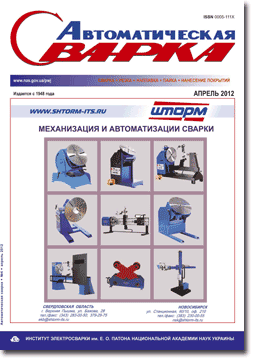| 2012 №04 (04) | 2012 №04 (06) |

«Автоматическая сварка», 2012, № 4, с. 24-35
МЕТАЛЛУРГИЧЕСКИЕ ОСОБЕННОСТИ СВАРКИ ВЫСОКОПРОЧНОГО АЛЮМИНИЕВОГО СПЛАВА 7025-Т6
Авторы
М. ОЛАБОДЕ, П. КАХ, Дж. МАРТИКАЙНЕН
(Техн. ун-т г. Лаппеенранта, Финляндия)
Реферат
Приведены обозначения, характеристики, области применения, свойства и особенности свариваемости высокопрочных алюминиевых сплавов. Исследовано влияние тепловложения на микроструктуру и твердость сварных соединений алюминиевого сплава 7025-Т6. Показано, что ограничение тепловложения при сварке высокопрочных алюминиевых сплавов имеет важное значение для обеспечения высоких физико-механических свойств металла соединений.
Ключевые слова: высокопрочные алюминиевые сплавы, сплав 7025-Т6, импульсная сварка МИГ, тепловложение, твердость по Виккерсу, металлургические особенности
Поступила в редакцию 31.10.2011
Опубликовано 20.03.2012
1. Yeomans S. R. Successful welding of aluminium and its alloys // Australian Welding J. — 1990. — 35, № 4. — P. 20–24.
2. Graeve I. D., Hirsch J. 7 Series alloys //aluminium.matter. org.uk/content/html/eng/default.asp?catid=214&pageid =2144417086.
3. Dickerson P. B., Irving B. Welding aluminium: It’s not as difficult as it sounds // Welding J. — 1992. — 71, № 4. — P. 45–50.
4. Mathers G. Knovel (Firm). The welding of aluminium and its alloys. — Boca Raton, Fla., Cambridge: CRC press; Woodhead publ., 2002.
5. Maurice S. Aluminum structures. Handbook of structural engineering. — Second ed. — CRC press, 1997.
6. Campbell F. C. Manufacturing technology for aerospace structural materials. — Amsterdam; San Diego: Elsevier, 2006. — 11 p.
7. Handbook committee and Knovel (Firm). ASM handbook, Casting. — ASM International, Materials Park, 2008. — Vol. 15. — 937 p.
8. Kopeliovich D. Сlassification of aluminum alloys. — Substances and Technology, 2009.
9. MatWeb — the online materials information resource // Matweb, 2010.
10. Kaufman G. J. Applications for aluminum alloys and tempers. — ASM International, 2000.
11. John D. Heat-treatable alloys // Aluminium design and construction. — New York, 1999. — 301 p.
12. Aluminum alloys and temper designations 101. — D. Industries, ed., Dayco Industries, Cal., 1987. — P. 1–5.
13. Volpone L. M., Mueller S. Joints in light alloys today: the boundaries of possibility // Welding Intern. — 2008. — 22, № 9. — P. 597–609.
14. George E. T., MacKenzie D. S. Handbook of aluminum. — New York: Marcel Dekker Inc., 2003.
15. Renshaw M. The welding of aluminium castings // Aluminium — light strong and beautiful. — A. F. o. S. Africa, 2004. — P. 11–13.
16. Choosing shielding gases for gas metal arc welding // Welding J. — 2008. — 87, № 4. — P. 32–34.
17. Boughton P., Matani T. M. Two years of pulsed arc welding // Welding and Metal Fabr. — 1967. — Oct. — P. 410–420.
18. Olson D. L. Handbook Committee and American Society for metals. Joining Division 1993 // Welding, Brazing and Soldering. — 1993. — 1299 p.
19. Blewett R. V. Welding aluminium and its alloys. — 1991. — № 59 (Oct.). — P. 5.
20. Ba Ruizhang G. S. Welding of aluminum-lithium alloy with a high power continuous wave Nd:YAG-laser. — IIW Doc. IV-866–04.
21. Hirata Y. Pulsed arc welding // Welding Intern. — 2003. — 17, № 2. — P. 98–115.
22. Chandler H. Hardness testing. — Ohio: ASM International, Materials Park, 1999.
23. Kou S. Welding metallurgy. — New York: Wiley-Interscience, Hoboken, 2003.
24. Hall-petch relationship in friction stir welds of equal channel angular-pressed aluminium alloys / Y. S. Sato, M. Urata, H. Kokawa, K. Ikeda // Materials Sci. and Eng. A. — 2003. — 354(1/2). — P. 298–305.
25. Vander Voort G. F. Metallography and microstructures. — Ohio: ASM International, Materials Park, 2004.
